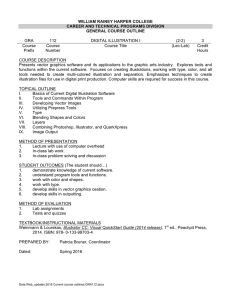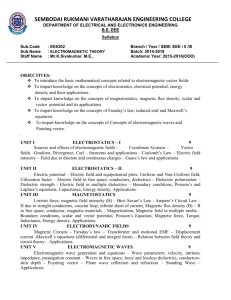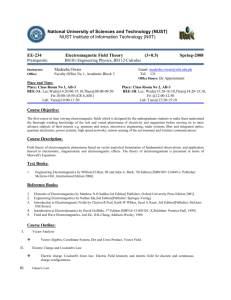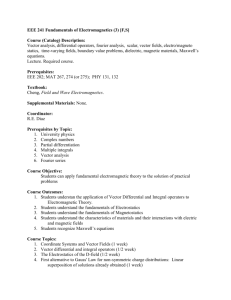EIE311 COURSE COMPACT Course Course code: EIE311 Course
advertisement
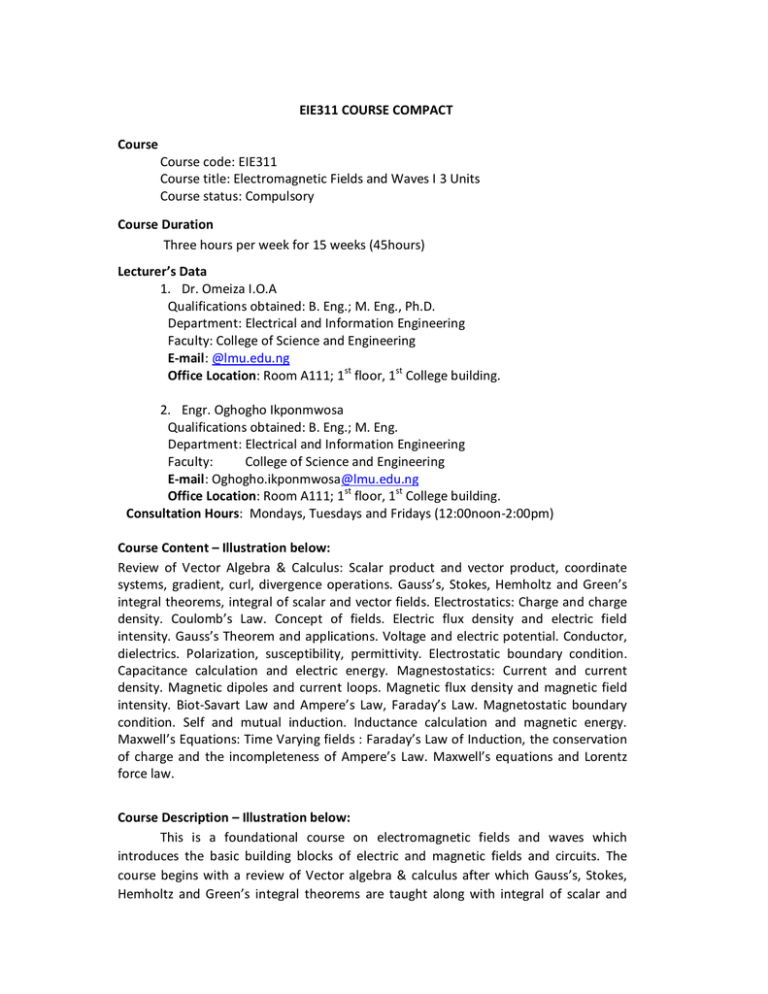
EIE311 COURSE COMPACT Course Course code: EIE311 Course title: Electromagnetic Fields and Waves I 3 Units Course status: Compulsory Course Duration Three hours per week for 15 weeks (45hours) Lecturer’s Data 1. Dr. Omeiza I.O.A Qualifications obtained: B. Eng.; M. Eng., Ph.D. Department: Electrical and Information Engineering Faculty: College of Science and Engineering E-mail: @lmu.edu.ng Office Location: Room A111; 1st floor, 1st College building. 2. Engr. Oghogho Ikponmwosa Qualifications obtained: B. Eng.; M. Eng. Department: Electrical and Information Engineering Faculty: College of Science and Engineering E-mail: Oghogho.ikponmwosa@lmu.edu.ng Office Location: Room A111; 1st floor, 1st College building. Consultation Hours: Mondays, Tuesdays and Fridays (12:00noon-2:00pm) Course Content – Illustration below: Review of Vector Algebra & Calculus: Scalar product and vector product, coordinate systems, gradient, curl, divergence operations. Gauss’s, Stokes, Hemholtz and Green’s integral theorems, integral of scalar and vector fields. Electrostatics: Charge and charge density. Coulomb’s Law. Concept of fields. Electric flux density and electric field intensity. Gauss’s Theorem and applications. Voltage and electric potential. Conductor, dielectrics. Polarization, susceptibility, permittivity. Electrostatic boundary condition. Capacitance calculation and electric energy. Magnestostatics: Current and current density. Magnetic dipoles and current loops. Magnetic flux density and magnetic field intensity. Biot-Savart Law and Ampere’s Law, Faraday’s Law. Magnetostatic boundary condition. Self and mutual induction. Inductance calculation and magnetic energy. Maxwell’s Equations: Time Varying fields : Faraday’s Law of Induction, the conservation of charge and the incompleteness of Ampere’s Law. Maxwell’s equations and Lorentz force law. Course Description – Illustration below: This is a foundational course on electromagnetic fields and waves which introduces the basic building blocks of electric and magnetic fields and circuits. The course begins with a review of Vector algebra & calculus after which Gauss’s, Stokes, Hemholtz and Green’s integral theorems are taught along with integral of scalar and vector fields. The concept of electrostatics, Coulomb’s Law and fields are taught. Electric flux density and electric field intensity as well as Gauss’s theorem and applications are covered. Voltage and electric potential, Conductors, dielectrics, Polarization, susceptibility, permittivity, electrostatic boundary condition, Capacitance calculation and electric energy are also covered. The course also covers magnestostatics: Current and current density, Magnetic dipoles and current loops, Magnetic flux density and magnetic field intensity. Biot-Savart Law, Ampere’s Law and Faraday’s Law are also covered. Magnetostatic boundary condition, Self and mutual induction, Inductance calculation and magnetic energy are introduced. Maxwell’s Equations for time varying fields: Faraday’s Law of Induction, the conservation of charge and the incompleteness of Ampere’s Law. Finally Maxwell’s equations and Lorentz force law are taught. Course Justification – Illustration below: This course is basic for the understanding of the properties and characteristics of electromagnetic fields and waves and the numerous theories used to describe them. Electromagnetic fields and waves are needed in Instrumentation systems, electric machines, Telecommunications systems etc. hence the student of electrical and electronic engineering must be taught these basics and the numerous principles as well as their applications so they can be ready to fit into the global world for which they are being trained. This course affords our students the privilege to have the fundamental knowledge and theory needed in numerous engineering fields where knowledge of electromagnetic fields and waves are required. Course objectives At the end of this course, students would be able to: (i) Develop a deeper and rigorous understanding as well as discuss the fundamental Principles of electromagnetic fields and waves. (ii) Understand the mathematical concepts of Vector Algebra & Calculus: Scalar product and vector product, coordinate systems, gradient, curl, divergence operations and be able to apply them to solve problems relating to electromagnetic fields and waves. (iii) Understand the basic concepts of Gauss’s, Stokes, Hemholtz and Green’s integral theorems and apply them to carry out integration of scalar and vector fields. (iv) Understand and discuss the concept of Electrostatics: Charge and charge density, Coulomb’s Law, Fields, Electric flux density and electric field intensity. (v) Understand and discuss Gauss’s theorem and their applications, Voltage and electric potential, Conductors, dielectrics, Polarization, susceptibility, permittivity. (vi) Understand and discuss the concept of Magnestostatics: Current and current density, Magnetic dipoles and current loops, (vii) Understand and discuss the concept of Electrostatic boundary condition and carry out Capacitance and electric energy calculation. (viii) Understand and discuss Magnetic flux density and magnetic field intensity and relate them to Biot-Savart Law, Ampere’s Law, Faraday’s Law. (ix) Understand and discuss Magnetostatic boundary condition, Self and mutual induction and carry out Inductance and magnetic energy calculation. (x) Derive Maxwell’s Equations for time Varying fields, Faraday’s Law of Induction, (xi) Discuss the conservation of charge and the incompleteness of Ampere’s Law (xii)Compare Maxwell’s equations and Lorentz force law. Course Requirement – Illustration below: To derive maximum benefits from the course and for fast grasping of many of the concept of electromagnetic fields and waves and the associated laws, the course requires that the students be familiar with basic electric and magnetic circuit theorems. The students should also have a good knowledge of basic mathematics like, algebra, vectors and calculus etc. However, the course is structured to accommodate to some extent, students that do not fall into this category since some of these basics will be introduced. A good knowledge and understanding of the course requires that students carry out some laboratory practical. This is done in another practical course compulsory for all 300Level students in the department. The method of grading is shown in Table1. Table1: Method of GradingS/N Grading 1. 1st Test 2. 2nd Test 3. 3rd Test 4. Assignment 5. Final Examination Total Score (%) 5 10 10 5 70 100 Course Delivery Strategies – Illustration below: 1. Lecture delivery with explanations using lecture notes, real life examples, diagrams and graphs. 2. The use of the University’s Intranet e-platform for quizzes, assignments, group discussions, etc. 3. Giving off net assignments and classwork. 4. Uploading the lecture materials on the e-learning platform. 5. Giving online assignments. 6. Having practical discussion sections at the end of the lecture. . LECTURE CONTENT For this section, the topic of each week, objectives, description, study question and other information are presented. 1. Week 1: Introduction to Electromagnetic Fields and Waves and Review of Vector algebra and calculus Objectives The students at the end of the lectures for the week should be able to: (i) Discuss the concept of Electromagnetic fields and waves (ii) Give the various areas of applications of Electromagnetic fields and waves. (iii) Carry out vector algebra and calculus operations such as scalar product, vector product, gradient, curl and divergence operations. Description First hour: Introduction to Electromagnetic fields and waves, review of Vector Algebra & Calculus: Scalar product Second hour: Vector product, coordinate systems, gradient, curl. Third hour: Divergence operations, Discussion and questions. Study Question: 1. Discuss the concept of electromagnetic field and list some areas of their applications. 2. Show that A=i + 2j -3k; B=2i-j+2k; and C=3i+j-k are coplanar Find the cylindrical coordinates equivalent of the following positions in Cartesian coordinates: (i) P(1,3,5), (ii) P(2,-2,-2), (iii) P( 1, -1/2, 3) 3. If A=x2zi + xyj +y2zk and B= yz2i + xzj + x2zk, find (i) Grad (A.B) (ii) Curl A (iii) Div B. Reading List - Books and materials students can read. Illustration below: 1. William H Hayt. Jr. and John A. Buck (2012) Engineering Electromagnetics. McGraw Hill. 2. Matthew N.O. Sadiku. Elements of Eectromagnetics. Oxford University Press. 3. Constantine A. Balamis. Advanced Engineering Electromagnetics. Wiley. ISBN 978-0-47058948-9. Week 2: Gauss’s, Stokes, Hemholtz and Green’s integral theorems Objectives At the end of the week, the students should be able to: 1. Understand the basic concepts of Gauss’s, Stokes, Hemholtz and Green’s integral theorems 2. Apply them to carry out integration of scalar and vector fields. Description First hour: Definition and explanation of Gauss’s, Stokes and Hemholtz theorem. Second hour: Definition and explanation of Green’s integral theorems. Third hour: Application of the theorems to carry out integration of scalar and vector fields, Discussion and questions. Study Question: 1. State Gauss’s, Stokes, Hemholtz and Green’s theorems. 2. With the aid of suitable diagrams discuss the explanation of the theorems in question 1. 3. Use Green’s Theorem to evaluate ∮ xy dx + x y dywhere c is the triangle with vertices (0,0), (1, 0), (1, 2) with positive orientation. Reading List - Books and materials students can read. Illustration below: 1. William H Hayt. Jr. and John A. Buck (2012) Engineering Electromagnetics. McGraw Hill. 2. Matthew N.O. Sadiku. Elements of Eectromagnetics. Oxford University Press. 3. Constantine A. Balamis. Advanced Engineering Electromagnetics. Wiley. ISBN 978-0-47058948-9. Week 3: Electrostatics and Electric flux density. Objectives At the end of the week, the students should be able to: 1. Develop a deeper understanding of the concept of electrostatics and discuss the concept in sufficient details. 2. Define and discuss Charge and charge density, Coulomb’s Law, Electric flux density and electric field intensity. 3. Solve problems involving Charge and charge density, Coulomb’s Law, Electric flux density and electric field intensity Description First hour: Electrostatics : Charge and charge density. Second hour: Coulomb’s Law, Fields, Electric flux density. Third hour: Electric field intensity, Discussion and questions. Study Question: 1. In sufficient details discuss the concept of Electrostatics. 2. Three point charges are positioned in the x-y plane as follows: 5 nC at y = 5 cm, 10 nC at y =-5 cm, and 15 nC at x =-5 cm. Find the required x-y coordinates of a 20-nC fourth charge that will produce a zero electric field at the origin. 3. Two point charges of equal magnitude q are positioned at z =±d/2. (a) Find the electric field everywhere on the z axis; (b) find the electric field everywhere on the x axis; (c) repeat parts (a) and (b) if the charge at z =-d/2is -q instead of +q. 4. A spherical volume having a 2-µm radius contains a uniform volume charge density of 1015C/m3 (a) What total charge is enclosed in the spherical volume? (b)Now assume that a large region contains one of these little spheres at every corner of a cubical grid 3 mm on a side and that there is no charge between the spheres. What is the average volume charge density throughout this large region? Reading List - Books and materials students can read. Illustration below: 1. William H Hayt. Jr. and John A. Buck (2012) Engineering Electromagnetics. McGraw Hill. 2. Matthew N.O. Sadiku. Elements of Eectromagnetics. Oxford University Press. 3. Constantine A. Balamis. Advanced Engineering Electromagnetics. Wiley. ISBN 978-0-47058948-9. 1. 2. 3. 4. Week 4: Gauss Theorem and Voltage and Electric Potential Objectives At the end of the week, the students should be able to: Define and discuss Gauss theorem. Apply Gauss theorem in solving real life problems. Define and discuss voltage and Electric potential. Discuss the concept of conductors, dielectrics, Polarization, susceptibility and permittivity. Description First hour: Gauss’s theorem and their applications, , Conductors, dielectrics, , Second hour: Voltage and electric potential. Third hour: Polarization, susceptibility, permittivity, Discussion and questions. Study Question: 1. 2. State and discuss Gauss law in sufficient details. 3. . 4. Reading List - Books and materials students can read. Illustration below: 1. William H Hayt. Jr. and John A. Buck (2012) Engineering Electromagnetics. McGraw Hill. 2. Matthew N.O. Sadiku. Elements of Eectromagnetics. Oxford University Press. 3. Constantine A. Balamis. Advanced Engineering Electromagnetics. Wiley. ISBN 978-0-47058948-9. Week 5: Objectives 1. Description First hour:. Second hour: . Third hour:. Study Question: 1. . 2. . 3. Reading List - Books and materials students can read. Illustration below: 1. 2. Week 6:. Objectives At the end of the week, the students should be able to: 1. . Description First hour:. Second hour: . Third hour:. Study Question: 1. . Reading List - Books and materials students can read. Illustration below: 1. Week 7:. Objectives At the end of the week, the students should be able to: 1. Description First hour:. Second hour: . Third hour: Discussion and questions. Study Question: 1. . 2. . Reading List - Books and materials students can read. Illustration below: 1. Week 8: Objectives At the end of the week, the students should be able to: 1. . Description First hour:. Second hour: . Third hour:. Study Question: Reading List - Books and materials students can read. Illustration below: 1. Week 9: Objectives At the end of the week, the students should be able to: 1. . Description First hour:, Second hour: . Third hour:, Discussion and questions. Study Question: 1. . Reading List - Books and materials students can read. Illustration below: 1. Week 10: Objectives At the end of the week, the students should be able to: 1. . Description First hour:. Second hour:. Third hour:. Study Question: 1. . Reading List - Books and materials students can read. Illustration below: 1. Week 11: Memory devices. Latches, Flip-flops Objectives At the end of the week, the students should be able to: 1. Description First hour:. Second hour: . Third hour: Discussion and Questions. Study Question: 1. . Reading List - Books and materials students can read. Illustration below: 1. Week 12: Counters, Registers and Timing Circuits Objectives At the end of the week, the students should be able to: 1. Description First hour:. Second hour: . Third hour: Discussion and Questions. Study Question: . Reading List - Books and materials students can read. Illustration below: 1. Week 13: Computer-aided Design of Modular Systems Objectives At the end of the week, the students should be able to: 1. . Description First hour:. Second hour: . Third hour: Discussion and Questions. Study Question: Reading List - Books and materials students can read. Illustration below: 1. Week 14 Topic: Revision Objectives: To briefly review all topics covered in the course Week 15 Topic: Examination Objectives: To examine the students on all that has been taught during the semester. Reading List: 1. William H Hayt. Jr. and John A. Buck (2012) Engineering Electromagnetics. McGraw Hill. 2. Matthew N.O. Sadiku. Elements of Eectromagnetics. Oxford University Press. 3. Constantine A. Balamis. Advanced Engineering Electromagnetics. Wiley. ISBN 978-0-47058948-9.
